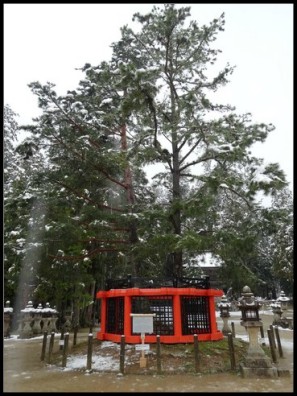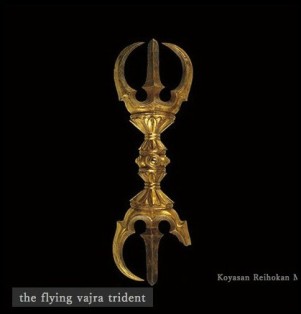
Having selected, in 816, with the assistance of this trusty vajra (see below), Koyasan as the base for the establishment of Shingon Buddhism in Japan, the priest Kukai (posthumously Kobo Daishi) set about building temples, meeting rooms, and above all the training area necessary for this new religion.

The Garan, which remains Koyasan’s central temple complex and the sacred core of Koyasan, was built over time with Kobo Daishi starting the Kondo Hall and the Konpon Daito Pagoda. His successors completed these and added many more buildings including the Toto (eastern pagoda), Saito (western pagoda) and the Koya Myojin Shrine, which enshrines Mount Koya’s local kami (Shinto deities).
It should be noted that nearly all of the buildings in the Garan are 19th – 20th century reconstructions, the originals having being lost, some many times, to fire and other misfortunes down the ages. This does not take from the sanctity nor the sereneness of the complex which is still very much the working headquarters of Shingon Buddhism in Japan.
A number of the buildings can be entered for a small fee ( a combination ticket is available covering the Garan and other sites). Unfortunately time didn’t let me visit any of the interiors though I did get a fleeting glance into a few from the entrances. I really wish I had have had at least one more day in Koyasan. I could have easily spent half a day, or more, at the Garan alone.
While Kodo Daishi has moved on from the Garan to his place of rest in the sacred Okunoin Cemetery, in the east of Koyasan, the peace and tranquillity that would have existed when he mediated here remains to-day.
 Now I will tell you a little about the Garan’s Holy Trees and then, in a couple of separate reviews to follow, a little more about various of the complex’s many buildings and structures.
Now I will tell you a little about the Garan’s Holy Trees and then, in a couple of separate reviews to follow, a little more about various of the complex’s many buildings and structures.
The priest Kukai, as you now know founder of Shingon Buddhism, was returning home in 806 from China where he had been studying. En route he prayed that he might be shown the ideal place to build a monastery/ headquarters for his new religion, on his return to Japan.
Legend has it that he threw his vajra – a double ended, three pronged Buddhist ceremonial tool and symbol of indestructible truth (picture here credit to Reihokan Museum, Koyasan) – into the Chinese air and it was whisked away on a cloud.  Having returned to Japan, while searching for a place to establish his religion he was guided to his vajra, stuck in the branch of this pine tree here in Koyasan. So it was that Koyasan became the home of Shingon Buddhism and this the site of Kukai’s first temple.
Having returned to Japan, while searching for a place to establish his religion he was guided to his vajra, stuck in the branch of this pine tree here in Koyasan. So it was that Koyasan became the home of Shingon Buddhism and this the site of Kukai’s first temple.
Since then this pine tree has been called the Sanko no Matsu or Three-pointed Vajra Pine Tree. While pine needles are usually found in clusters of two to five needles, those on this tree miraculously consistently come in clusters of three. Should you see pilgrims searching around on the ground by the tree they will invariably not be looking for a lost contact lens but rather a cluster of three pine needles, the finding of which will bring them good fortune.
While on trees, there is another famous tree to look out for here at the Garan, this time a cherry tree planted in the late 1100’s by the monk and poet Saigyo who was living here at the time. While I like it, my snow covered picture of the tree doesn’t present it at its best.

The Garan grounds are open 24/7 and are free to access.
While we didn’t have a chance to visit it, the Koyasan Reihokan Museum, which contains many important cultural and religious relics from the area, is located next to the Garan.
Address: 152 Koyasan, Koyasan
Directions: In the centre of Koyasan
For my next KOYASAN review click HERE.
To start reading at the beginning of my Koyasan reviews click HERE.



I love the splashes of red in your snowy photos – very atmospheric 🙂
LikeLike
While the snow and gray sky dulled other colours it tended to bring out the red.
LikeLike